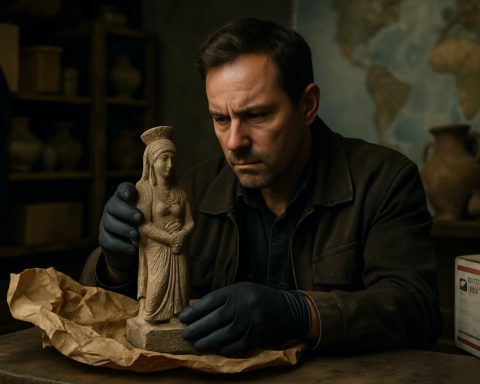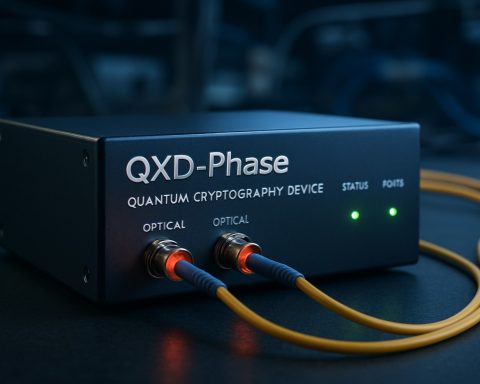Inside the Shadowy World of Antiquities Trafficking: How Illicit Trade Threatens Cultural Heritage and Fuels International Crime. Discover the Networks, Tactics, and Global Response to This Growing Crisis. (2025)
- Introduction: Defining Antiquities Trafficking and Its Global Scope
- Historical Context: Notorious Cases and Evolution of the Trade
- Key Players: Smugglers, Dealers, Collectors, and Intermediaries
- Trafficking Routes: Hotspots, Transit Countries, and Methods
- Impact on Source Countries: Cultural, Economic, and Social Consequences
- Law Enforcement and International Cooperation: Interpol, UNESCO, and National Agencies
- Technological Advances: Tracking, Authentication, and Digital Forensics
- Market Trends and Public Interest: Growth Estimates and Demand Drivers
- Legal Frameworks: International Conventions and National Laws
- Future Outlook: Emerging Threats, Policy Innovations, and the Road Ahead
- Sources & References
Introduction: Defining Antiquities Trafficking and Its Global Scope
Antiquities trafficking refers to the illicit trade, smuggling, and sale of cultural artifacts, artworks, and archaeological objects that are often stolen or illegally excavated from their countries of origin. This black market activity undermines cultural heritage, finances organized crime, and deprives nations and communities of their historical legacy. The global scope of antiquities trafficking is vast, with networks spanning continents and involving a complex web of looters, intermediaries, and buyers. The United Nations Educational, Scientific and Cultural Organization (UNESCO), a leading authority in cultural heritage protection, estimates that the illicit trade in cultural property is worth billions of dollars annually, ranking it among the most lucrative transnational crimes worldwide.
In 2025, antiquities trafficking remains a persistent challenge, exacerbated by ongoing conflicts, political instability, and the proliferation of online marketplaces. Regions such as the Middle East, North Africa, and Southeast Asia are particularly vulnerable due to their rich archaeological sites and, in some cases, limited resources for site protection. The looting of sites in Syria, Iraq, and Libya during periods of conflict has led to the loss of countless artifacts, many of which have surfaced in international art markets and private collections. The INTERPOL, the world’s largest international police organization, maintains a database of stolen works of art and coordinates cross-border investigations to combat this crime. In 2023 and 2024, INTERPOL reported a continued rise in the number of recovered artifacts, but also noted the increasing sophistication of trafficking networks.
The global response to antiquities trafficking involves a combination of international treaties, national legislation, and collaborative enforcement efforts. The 1970 UNESCO Convention, ratified by over 140 countries, provides a legal framework for the prevention of illicit import, export, and transfer of ownership of cultural property. In recent years, the United Nations Office on Drugs and Crime (UNODC) has intensified its efforts to support member states in strengthening legal frameworks and enhancing law enforcement capacities. Technological advancements, such as digital registries and blockchain-based provenance tracking, are being explored to improve artifact traceability and deter illegal sales.
Looking ahead, the outlook for combating antiquities trafficking in 2025 and beyond will depend on sustained international cooperation, the adoption of innovative technologies, and increased public awareness. As the demand for cultural artifacts persists, so too does the need for robust preventive measures and the restoration of stolen heritage to its rightful communities.
Historical Context: Notorious Cases and Evolution of the Trade
Antiquities trafficking, the illicit trade in cultural artifacts, has a long and complex history, evolving alongside global conflicts, economic shifts, and advances in technology. Notorious cases over the past decades have shaped international awareness and policy, while the methods and scale of trafficking have adapted to new challenges and opportunities.
One of the most infamous cases remains the looting of the National Museum of Iraq in 2003, where thousands of priceless artifacts were stolen during the chaos following the invasion. Many of these items, including Sumerian, Babylonian, and Assyrian treasures, entered the black market, highlighting the vulnerability of cultural heritage during conflict. The subsequent recovery efforts, led by organizations such as INTERPOL and UNESCO, set precedents for international cooperation and the creation of databases to track stolen artifacts.
The 2010s and early 2020s saw a surge in trafficking linked to conflict zones, particularly in Syria and Iraq, where terrorist groups exploited antiquities as a source of funding. The destruction and looting of sites like Palmyra drew global condemnation and prompted the strengthening of legal frameworks, such as the 1970 UNESCO Convention, which many countries have since ratified or reinforced. The United Nations has repeatedly called for member states to prevent the trade in looted cultural property, recognizing its role in financing organized crime and terrorism.
Recent years have also seen high-profile repatriation cases. In 2021, the United States returned over 17,000 artifacts to Iraq, including the ancient Gilgamesh Dream Tablet, after coordinated investigations by the Federal Bureau of Investigation and customs authorities. Similarly, Italy and Greece have intensified efforts to recover looted antiquities, often collaborating with auction houses and museums to identify and return stolen items.
The evolution of the trade has been marked by increasing sophistication. Traffickers now use online platforms, encrypted communications, and falsified provenance documents to move artifacts across borders. In response, agencies like INTERPOL have developed specialized units and digital tools, such as the INTERPOL Stolen Works of Art Database, to aid in detection and recovery.
Looking ahead to 2025 and beyond, experts anticipate that antiquities trafficking will remain a significant challenge, particularly as instability persists in certain regions and demand for rare artifacts continues. However, the growing use of digital tracking, international legal cooperation, and public awareness campaigns are expected to improve the identification and repatriation of trafficked antiquities. The ongoing evolution of both criminal tactics and enforcement strategies will shape the future landscape of this illicit trade.
Key Players: Smugglers, Dealers, Collectors, and Intermediaries
Antiquities trafficking remains a complex, transnational crime involving a network of key players whose roles and methods are evolving in 2025. The principal actors include smugglers, dealers, collectors, and intermediaries, each contributing to the illicit movement of cultural property from source countries to the global art market.
Smugglers are often the first link in the chain, operating in regions rich in archaeological heritage but vulnerable to looting due to conflict, weak governance, or economic hardship. In 2025, hotspots include the Middle East, North Africa, and parts of South Asia, where ongoing instability facilitates the illegal extraction and movement of artifacts. Smugglers employ increasingly sophisticated methods, such as falsified documentation, concealed shipments, and the use of digital platforms to coordinate logistics and evade detection. International law enforcement agencies, including INTERPOL, have reported a rise in the use of encrypted messaging apps and cryptocurrencies to obscure transactions and identities.
Dealers act as intermediaries between smugglers and buyers, often operating in the gray areas of the legitimate art market. Some dealers knowingly traffic in illicit antiquities, while others may be complicit through willful ignorance or inadequate due diligence. In 2025, regulatory scrutiny is increasing, with organizations such as UNESCO and UNODC (United Nations Office on Drugs and Crime) promoting stricter provenance requirements and transparency in art transactions. However, the global nature of the market and varying national laws continue to present enforcement challenges.
Collectors—both private individuals and institutions—drive demand for antiquities, sometimes prioritizing prestige or investment over legal and ethical considerations. While some collectors are unwitting participants, others actively seek out rare artifacts regardless of origin. In recent years, high-profile repatriation cases and public awareness campaigns have pressured museums and private collectors to scrutinize their acquisitions more closely. Nevertheless, the allure of unique objects and the opacity of the market mean that illicit antiquities still find their way into prominent collections.
Intermediaries—including transporters, forgers, and corrupt officials—facilitate the movement and laundering of antiquities. For example, forgers may create false provenance documents, while complicit customs agents enable the passage of illicit goods across borders. In 2025, international cooperation is intensifying, with joint operations and information-sharing initiatives led by entities such as INTERPOL and UNESCO targeting these networks.
Looking ahead, the outlook for antiquities trafficking is shaped by technological advancements, evolving criminal tactics, and the ongoing efforts of international organizations. While enforcement and awareness are improving, the adaptability of traffickers and persistent demand suggest that antiquities trafficking will remain a significant challenge in the coming years.
Trafficking Routes: Hotspots, Transit Countries, and Methods
Antiquities trafficking remains a significant transnational crime in 2025, with evolving routes, persistent hotspots, and increasingly sophisticated smuggling methods. The illicit trade in cultural property is driven by ongoing conflict, political instability, and high demand in global art markets. Key source countries continue to include regions with rich archaeological heritage and limited resources for site protection, such as the Middle East, North Africa, and parts of South Asia. Notably, Syria, Iraq, and Libya remain hotspots due to ongoing instability and the presence of organized criminal networks exploiting weakened state controls.
Transit countries play a crucial role in the movement of trafficked antiquities. In recent years, Turkey has remained a major transit hub, given its proximity to conflict zones and established smuggling routes into Europe. The Eastern Mediterranean, including Lebanon and Cyprus, also serves as a staging ground for moving artifacts to Western markets. In Southeast Asia, Cambodia and Thailand are both source and transit countries for looted antiquities, with items often routed through regional trade centers before reaching buyers in Europe, North America, and East Asia.
The methods employed by traffickers have adapted to increased scrutiny and international cooperation. Smugglers frequently use falsified documentation, conceal artifacts within legitimate shipments, and exploit free trade zones to obscure provenance. The use of online platforms and encrypted communications has expanded, allowing traffickers to connect with buyers and coordinate logistics with reduced risk of detection. Authorities have reported a rise in the use of small, decentralized shipments to avoid large-scale seizures, as well as the laundering of artifacts through reputable auction houses and galleries.
International organizations such as UNESCO and INTERPOL have intensified efforts to disrupt trafficking networks. INTERPOL’s Works of Art unit maintains a global database of stolen cultural property and coordinates cross-border investigations, while UNESCO continues to promote the implementation of the 1970 Convention, which obliges member states to prevent the illicit import, export, and transfer of ownership of cultural property. The United Nations Office on Drugs and Crime (UNODC) also supports capacity-building and legislative reforms in vulnerable countries.
Looking ahead, the outlook for antiquities trafficking routes suggests continued adaptation by criminal networks. The proliferation of digital marketplaces and the persistence of conflict in key regions are likely to sustain demand and supply. However, enhanced international cooperation, improved border controls, and the adoption of new technologies for artifact identification and tracking may gradually constrain trafficking flows over the next few years.
Impact on Source Countries: Cultural, Economic, and Social Consequences
Antiquities trafficking continues to inflict profound cultural, economic, and social consequences on source countries in 2025, with projections indicating persistent challenges in the coming years. The illicit trade in cultural property strips nations of their heritage, undermines local economies, and destabilizes communities.
Culturally, the removal of artifacts erodes national identity and collective memory. Many source countries, particularly in the Middle East, North Africa, and Southeast Asia, have reported significant losses of archaeological material due to ongoing conflict and organized looting. The United Nations Educational, Scientific and Cultural Organization (UNESCO) has repeatedly emphasized that the destruction and theft of cultural property not only deprive communities of their history but also impede post-conflict reconciliation and nation-building efforts. In 2025, UNESCO continues to coordinate international responses and capacity-building programs to help affected countries inventory and recover stolen artifacts.
Economically, antiquities trafficking deprives source countries of potential revenue from cultural tourism and legal antiquities markets. The International Criminal Police Organization (INTERPOL) has documented that the black market for antiquities remains lucrative, with criminal networks exploiting weak border controls and limited law enforcement resources. This diversion of cultural assets undermines sustainable development, as communities lose opportunities for employment and investment linked to heritage sites. In response, several countries have increased investment in site protection and digital documentation, but resource constraints remain a significant barrier.
Socially, the trafficking of antiquities often fuels corruption, violence, and instability. Criminal groups involved in the illicit trade may use proceeds to finance other illegal activities, including arms and drug trafficking. The United Nations Office on Drugs and Crime (UNODC) has highlighted the intersection between antiquities trafficking and transnational organized crime, noting that vulnerable populations—such as rural communities and displaced persons—are frequently exploited as intermediaries or laborers in looting operations. This dynamic exacerbates social fragmentation and undermines trust in public institutions.
Looking ahead, international organizations and national governments are expected to intensify efforts to combat antiquities trafficking through enhanced legal frameworks, cross-border cooperation, and public awareness campaigns. However, the persistence of conflict, economic hardship, and demand in global art markets suggests that source countries will continue to face significant cultural, economic, and social challenges related to antiquities trafficking in the near future.
Law Enforcement and International Cooperation: Interpol, UNESCO, and National Agencies
Antiquities trafficking remains a significant challenge for law enforcement and cultural heritage organizations worldwide, with 2025 seeing both persistent threats and evolving strategies. The illicit trade in cultural property is estimated to be worth billions annually, often linked to organized crime and, in some cases, financing of armed conflict. In response, international cooperation has intensified, with key roles played by organizations such as INTERPOL, UNESCO, and national agencies.
INTERPOL, the world’s largest international police organization, continues to coordinate global efforts against antiquities trafficking through its Works of Art unit. In 2024 and into 2025, INTERPOL has expanded its Stolen Works of Art Database, which now contains over 52,000 objects, and has enhanced its public access portal to facilitate identification and recovery of stolen items. INTERPOL’s annual Operation Pandora, conducted in partnership with Europol and the World Customs Organization, has resulted in thousands of seizures and hundreds of arrests in recent years, with the 2024 operation recovering over 11,000 cultural objects across 28 countries. These operations are expected to continue and expand in 2025, with increased use of digital tools and artificial intelligence for tracking and analysis.
UNESCO, the United Nations agency responsible for education, science, and culture, plays a pivotal role in setting international standards and fostering cooperation. The 1970 UNESCO Convention, which provides a legal framework for preventing the illicit import, export, and transfer of ownership of cultural property, has seen growing adoption and implementation. In 2025, UNESCO is focusing on strengthening national legislation, capacity building, and public awareness campaigns. The agency is also working closely with member states to update inventories and improve documentation, which are critical for provenance research and restitution efforts.
National agencies, such as customs authorities, specialized police units, and ministries of culture, are increasingly collaborating through bilateral and multilateral agreements. Countries like Italy, France, and Egypt have established dedicated art crime units that have achieved notable recoveries and prosecutions. The United States, through Homeland Security Investigations, continues to repatriate significant artifacts to their countries of origin. In 2025, more countries are expected to adopt digital registries and blockchain-based provenance tracking to combat forgery and facilitate cross-border cooperation.
Looking ahead, the outlook for law enforcement and international cooperation in antiquities trafficking is cautiously optimistic. While traffickers are adopting new technologies and routes, the global response is becoming more coordinated and technologically advanced. Continued investment in training, information sharing, and legal harmonization will be essential to disrupt trafficking networks and protect the world’s cultural heritage.
Technological Advances: Tracking, Authentication, and Digital Forensics
In 2025, the fight against antiquities trafficking is increasingly shaped by technological innovation, with significant advances in tracking, authentication, and digital forensics. These tools are being deployed by law enforcement agencies, museums, and international organizations to counteract the illicit trade in cultural heritage, which remains a multi-billion-dollar global problem.
One of the most impactful developments is the use of blockchain technology to create immutable digital ledgers for provenance tracking. By recording each transaction and transfer of ownership, blockchain systems help establish transparent histories for artifacts, making it more difficult for traffickers to launder looted items into the legitimate market. Several pilot projects, often in collaboration with major museums and cultural ministries, are underway to test the scalability and interoperability of these systems.
Artificial intelligence (AI) and machine learning are also being leveraged to analyze vast datasets of images and documentation. AI-powered image recognition tools can compare photographs of seized objects with databases of stolen or missing artifacts, such as those maintained by INTERPOL and UNESCO. These databases are continually updated and serve as critical resources for customs officials and investigators worldwide. In 2024, INTERPOL expanded its Stolen Works of Art database, integrating new AI-driven search capabilities to improve identification accuracy and speed.
Digital forensics has become central to the authentication process. Techniques such as 3D scanning, multispectral imaging, and material analysis allow experts to detect forgeries and reconstruct the original context of looted objects. For example, 3D models can be shared globally, enabling remote collaboration between experts and facilitating the repatriation process. The International Council of Museums (ICOM) has promoted the adoption of these technologies through its Red Lists and capacity-building initiatives, aiming to standardize digital documentation practices across institutions.
Looking ahead, the integration of these technologies is expected to accelerate, with increased cross-border data sharing and the development of interoperable platforms. However, challenges remain, including the need for international legal frameworks to govern digital evidence and the risk of traffickers exploiting technological gaps. The ongoing collaboration between law enforcement, cultural institutions, and technology providers will be crucial in closing these loopholes and ensuring that advances in digital forensics and authentication translate into tangible reductions in antiquities trafficking.
Market Trends and Public Interest: Growth Estimates and Demand Drivers
The global landscape of antiquities trafficking in 2025 is shaped by a complex interplay of market demand, regulatory responses, and technological advancements. The illicit trade in cultural property remains a multi-billion-dollar black market, with estimates from UNESCO and INTERPOL consistently ranking it among the world’s most lucrative forms of transnational crime. Demand is driven by private collectors, auction houses, and, increasingly, online marketplaces, which have expanded the reach and anonymity of transactions.
Recent years have seen a surge in public and institutional awareness, partly due to high-profile repatriation cases and the growing role of social media in exposing illicit sales. In 2025, the market for trafficked antiquities is expected to remain robust, particularly for artifacts from conflict zones in the Middle East, North Africa, and parts of Asia. The ongoing instability in these regions continues to provide opportunities for looting and smuggling, with traffickers exploiting gaps in local enforcement and border controls.
Technological innovation is a double-edged sword in this sector. On one hand, digital platforms and cryptocurrencies facilitate the discreet movement of illicit goods and payments. On the other, advances in provenance research, blockchain-based registries, and image recognition are empowering authorities and cultural institutions to track and recover stolen items more effectively. Organizations such as UNESCO and INTERPOL have intensified their efforts to coordinate international databases and alert systems, aiming to stem the flow of trafficked objects.
Market trends indicate a shift in collector attitudes, with increased scrutiny on provenance and legal ownership. Major auction houses and museums are under mounting pressure to conduct due diligence, as regulatory frameworks tighten in the European Union and North America. The UNESCO 1970 Convention continues to serve as a cornerstone for international cooperation, and more countries are expected to ratify or strengthen their implementation in the coming years.
Looking ahead, the outlook for antiquities trafficking is shaped by both persistent demand and evolving countermeasures. While the black market is unlikely to contract significantly in the near term, ongoing collaboration between governments, law enforcement, and cultural organizations is expected to yield incremental progress. Public interest in cultural heritage protection is also rising, suggesting that consumer behavior and institutional policies may gradually shift toward greater transparency and ethical stewardship.
Legal Frameworks: International Conventions and National Laws
The legal landscape addressing antiquities trafficking in 2025 is shaped by a complex interplay of international conventions and evolving national laws. The cornerstone of international efforts remains the 1970 UNESCO Convention, which obligates signatory states to prevent the illicit import, export, and transfer of ownership of cultural property. As of 2025, over 140 countries have ratified this convention, reinforcing its global reach. The United Nations Educational, Scientific and Cultural Organization (UNESCO) continues to coordinate international cooperation, capacity building, and information sharing among member states to strengthen enforcement and compliance.
Complementing UNESCO’s framework, the 1995 UNIDROIT Convention addresses private law aspects, focusing on the restitution of stolen or illegally exported cultural objects. While fewer countries have ratified this convention, its influence is growing, with several states in 2024–2025 considering adoption or harmonization of their national laws to align with its provisions. The International Institute for the Unification of Private Law (UNIDROIT) actively supports these legislative efforts and provides guidance on best practices for restitution claims.
At the national level, legislative reforms are accelerating in response to increased awareness of the links between antiquities trafficking, organized crime, and even terrorist financing. In 2024 and 2025, countries such as France, Germany, and the United States have introduced or updated laws to tighten import controls, enhance provenance requirements, and increase penalties for violations. The U.S. Immigration and Customs Enforcement (ICE) continues to play a leading role in investigating and prosecuting antiquities trafficking cases, often in collaboration with international partners.
The European Union is also advancing its regulatory framework. The EU Regulation 2019/880 on the import of cultural goods, which entered into force in 2025, establishes stricter documentation and due diligence requirements for importers, aiming to prevent the entry of illicit antiquities into the EU market. The European Union is working closely with member states to ensure effective implementation and cross-border cooperation.
Looking ahead, the outlook for legal frameworks combating antiquities trafficking is one of continued strengthening and harmonization. International organizations are prioritizing digital tools for tracking provenance and sharing intelligence, while national authorities are expected to further align their laws with international standards. However, challenges remain, particularly in regions affected by conflict or with limited enforcement capacity. Ongoing collaboration between states, international bodies, and the art market will be crucial to closing legal loopholes and reducing the illicit trade in antiquities in the coming years.
Future Outlook: Emerging Threats, Policy Innovations, and the Road Ahead
The future of antiquities trafficking is shaped by evolving criminal tactics, technological advancements, and shifting geopolitical landscapes. As of 2025, the illicit trade in cultural property remains a multibillion-dollar global enterprise, with traffickers exploiting conflict zones, weak border controls, and digital platforms to move stolen artifacts. The United Nations Educational, Scientific and Cultural Organization (UNESCO), the primary international body for cultural heritage protection, continues to warn that instability in regions such as the Middle East and North Africa fuels the looting and smuggling of antiquities, with proceeds often linked to organized crime and terrorist financing.
Emerging threats include the increasing use of online marketplaces and social media for the sale and advertisement of illicit artifacts. Traffickers leverage encrypted messaging apps and anonymous payment systems, complicating law enforcement efforts. The INTERPOL database of stolen works of art, which is accessible to police and customs officials worldwide, has seen a surge in digital entries, reflecting both the scale of the problem and the growing reliance on technology for detection and recovery.
Policy innovations are underway to counter these threats. In 2024, the European Union strengthened its import regulations on cultural goods, requiring documentation of legal provenance for artifacts entering the bloc. The United States, through the Department of Homeland Security and the Department of State, has expanded bilateral agreements with source countries to facilitate the repatriation of trafficked items and to support capacity-building for local law enforcement. Internationally, the United Nations Office on Drugs and Crime (UNODC) is piloting blockchain-based tracking systems to enhance the traceability of cultural objects and to provide immutable records of ownership and transfer.
Looking ahead, experts anticipate that artificial intelligence and machine learning will play a greater role in identifying looted artifacts, both online and at border checkpoints. Collaborative databases and image recognition tools are expected to improve the speed and accuracy of artifact identification. However, traffickers are also likely to adapt, employing more sophisticated forgeries and exploiting legal loopholes in countries with weak enforcement.
The road ahead will require sustained international cooperation, robust legal frameworks, and public awareness campaigns. Organizations such as UNESCO and INTERPOL are expected to expand their partnerships with the private sector, including auction houses and online platforms, to stem the flow of illicit antiquities. While progress is being made, the dynamic nature of antiquities trafficking demands constant vigilance and innovation to protect the world’s shared cultural heritage.
Sources & References
- UNESCO
- United Nations Office on Drugs and Crime
- United Nations
- UNESCO
- International Council of Museums (ICOM)
- International Institute for the Unification of Private Law (UNIDROIT)
- European Union









